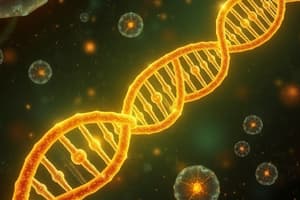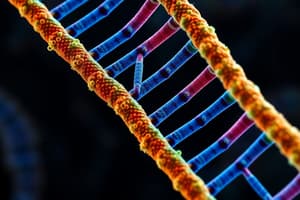Podcast
Questions and Answers
What is the approximate total length of DNA in a single human cell?
What is the approximate total length of DNA in a single human cell?
- 1 meter
- 2 meters (correct)
- 3 meters
- 5 meters
How must the DNA be configured to fit within a cell?
How must the DNA be configured to fit within a cell?
- It should be fragmented into smaller pieces.
- It must be dissolved in the cytoplasm.
- It must be coiled and compacted. (correct)
- It should be stretched out fully.
Which of the following best describes the challenge of fitting DNA in a cell?
Which of the following best describes the challenge of fitting DNA in a cell?
- Cells must constantly measure DNA length.
- The DNA is too thin to be perceived.
- Only a small portion of DNA is functional.
- DNA is extremely long and must be organized. (correct)
What role does the diameter of a cell play in containing its DNA?
What role does the diameter of a cell play in containing its DNA?
Why is the configuration of DNA critical for cellular function?
Why is the configuration of DNA critical for cellular function?
What is the approximate total length of DNA in a single human cell?
What is the approximate total length of DNA in a single human cell?
DNA must be contained within cells of ______ diameter.
DNA must be contained within cells of ______ diameter.
What is a key consideration for the organization of DNA within a cell?
What is a key consideration for the organization of DNA within a cell?
Which factor primarily contributes to the challenge of fitting DNA into a cell?
Which factor primarily contributes to the challenge of fitting DNA into a cell?
How does the length of DNA in a single human cell compare to typical cell sizes?
How does the length of DNA in a single human cell compare to typical cell sizes?
What is a result of the DNA's length in relation to cellular function?
What is a result of the DNA's length in relation to cellular function?
Why is the configuration of DNA critical for its containment in a cell?
Why is the configuration of DNA critical for its containment in a cell?
What is a significant property of the DNA in a human cell that influences its storage?
What is a significant property of the DNA in a human cell that influences its storage?
Which statement best explains how the length of DNA affects cellular organization?
Which statement best explains how the length of DNA affects cellular organization?
Which of the following most accurately reflects the relationship between DNA length and cell diameter?
Which of the following most accurately reflects the relationship between DNA length and cell diameter?
What is a consequence of the cellular diameter in relation to DNA storage?
What is a consequence of the cellular diameter in relation to DNA storage?
How does the configuration of DNA within the cell relate to its functional integrity?
How does the configuration of DNA within the cell relate to its functional integrity?
What is the approximate total linear length of DNA in a single human cell?
What is the approximate total linear length of DNA in a single human cell?
What implication does the length of cellular DNA have for cellular structure?
What implication does the length of cellular DNA have for cellular structure?
Which of the following best describes the challenge presented by the length of DNA in human cells?
Which of the following best describes the challenge presented by the length of DNA in human cells?
How does the diameter of a cell relate to the organization of DNA within it?
How does the diameter of a cell relate to the organization of DNA within it?
What factor primarily affects how DNA is contained within a cell?
What factor primarily affects how DNA is contained within a cell?
What is a primary reason DNA must be compactly stored within cells?
What is a primary reason DNA must be compactly stored within cells?
Which statement accurately characterizes the total length of DNA in a single human cell?
Which statement accurately characterizes the total length of DNA in a single human cell?
What cellular structure is most essential for ensuring DNA fits within the confines of a cell?
What cellular structure is most essential for ensuring DNA fits within the confines of a cell?
Why is the diameter of a cell critical in relation to its DNA?
Why is the diameter of a cell critical in relation to its DNA?
How does the organization of DNA affect its role in a cell?
How does the organization of DNA affect its role in a cell?
Flashcards are hidden until you start studying
Study Notes
DNA Length in a Human Cell
- The total length of DNA in a single human cell is approximately 2 meters.
DNA Configuration
- DNA is configured into a compact structure called chromatin to fit within the nucleus of a cell.
- Chromatin is a complex of DNA and proteins called histones.
- Histones help to package and organize DNA, allowing it to be tightly wound and stored within the nucleus.
Challenge of Fitting DNA
- The challenge of fitting DNA in a cell is akin to fitting a 2-meter long string into a space the size of a pinhead.
Cell Diameter and DNA
- The diameter of a cell plays a crucial role in containing its DNA.
- The tight packaging of DNA into chromatin allows such a large amount of genetic material to be confined within the relatively small space of a cell's nucleus.
Configuration of DNA and Cellular Function
- The configuration of DNA is critical for cellular function.
- This compact structure regulates gene expression, allowing specific regions of DNA to be accessed for transcription and translation, while keeping other regions inactive.
- This controlled access to genetic information is essential for the proper development and functioning of a cell.
DNA Length and Configuration
- The total length of DNA in a single human cell is approximately 2 meters.
- This massive length of DNA must be compacted to fit within a cell with a diameter of about 10 micrometers.
- The challenge of fitting DNA in a cell is akin to trying to fit 40 miles of thread into a tennis ball.
DNA Configuration and Cellular Function
- The DNA is coiled and packed into structures called chromosomes.
- The diameter of a cell plays a critical role in containing its DNA, as it determines the available space for the compacting and packaging of the DNA.
- Specific proteins help in folding and arranging the DNA into a compact, organized structure.
- The configuration of DNA is critical for cellular function, as it allows for proper organization, duplication, and expression of genetic information.
DNA Length and Cellular Containment
- The total length of DNA in a single human cell is approximately 2 meters.
- This DNA must be configured to fit within a cell with a diameter of approximately 10 micrometers.
- The key challenge of fitting DNA in a cell is its immense length compared to the cell's size.
- This configuration of DNA is critical for cellular function as it allows for proper replication, transcription, and translation processes.
Challenges of DNA Packaging
- The diameter of a cell plays a vital role in containing its DNA by providing limited space.
- The configuration of DNA is crucial for its containment within the cell, as it allows for compact packaging and efficient organization.
- The extensive length of DNA, exceeding the cell's size by several orders of magnitude, poses a major challenge.
- This challenge is primarily attributed to the vast size difference between the length of the DNA and the cell's dimensions.
- The extreme length of DNA relative to the cell's size necessitates sophisticated packaging strategies for proper function.
DNA Length and Cellular Organization
- The total length of DNA in a single human cell is approximately 2 meters.
- DNA must be configured to fit within cells of approximately 10 micrometers in diameter.
- The key consideration for the organization of DNA within a cell is the enormous length of DNA relative to the size of the cell.
- The challenge of fitting DNA in a cell is primarily due to the extremely long length of the DNA molecule relative to the cell's diameter.
- The length of DNA in a single human cell is far greater than typical cell sizes, posing a significant challenge for storage.
- The DNA's length leads to the need for highly organized packaging and efficient storage within the cell.
- The configuration of DNA is critical for its containment in a cell due to the enormous length difference between the DNA molecule and the nuclear space.
- A significant property of DNA in a human cell that influences its storage is its extreme length.
- The length of DNA affects cellular organization by requiring complex mechanisms for packing and storing the molecule within the nucleus.
- The relationship between DNA length and cell diameter is that the length of DNA greatly exceeds the diameter of the cell, necessitating efficient packaging.
- A consequence of the cellular diameter in relation to DNA storage is the need for compact and organized structures like chromosomes.
- The configuration of DNA within the cell relates to its functional integrity by allowing for controlled access to specific genes and regulated gene expression.
- The approximate total linear length of DNA in a single human cell is around 2 meters.
- The length of cellular DNA implies the necessity for a highly organized and compact structure within the nucleus.
- The challenge presented by the length of DNA in human cells is how to efficiently store and organize such a long molecule within a confined space.
- The diameter of a cell relates to the organization of DNA within it by dictating the space available for storage and the need for compact structures like chromosomes.
- The factor primarily affecting how DNA is contained within a cell is the length of the DNA molecule relative to the cell's size.
DNA Length and Cellular Organization
- The total length of DNA in a single human cell is approximately 2 meters.
- DNA must be contained within cells of approximately 10 micrometers in diameter.
- A key consideration for the organization of DNA within a cell is its extreme length in relation to the cell's size.
- The challenge of fitting DNA in a cell is primarily due to its enormous length compared to the tiny diameter of the cell.
- The configuration of DNA is critical for cellular function because it allows for efficient access to genetic information during processes like replication and transcription.
- The configuration of DNA within the cell relates to its functional integrity by ensuring that the DNA is organized and protected while still permitting the necessary interactions with other cellular components.
- The length of cellular DNA has significant implications for cellular structure, requiring specialized packaging and organization strategies.
- The approximate total linear length of DNA in a single human cell is 2 meters, which is thousands of times longer than the cell itself.
DNA Length
- The total linear length of DNA in a single human cell is approximately 2 meters.
DNA Configuration
- To fit within a cell of approximately 100 micrometers in diameter, DNA must be highly organized and compactly packed.
Challenges of DNA Packaging
- The primary challenge of fitting DNA in a cell is the extreme length of DNA in relation to the limited space available within the cell.
Cell Diameter and DNA Containment
- The small diameter of a cell is a significant contributing factor to the need for DNA packaging.
Significance of DNA Configuration
- The configuration of DNA is essential for cellular function because it allows for:
- Efficient storage and protection of the genetic material
- Regulation of gene expression
- Replication and repair of the DNA
Key Considerations for DNA Organization
- A key consideration for the organization of DNA is its length in relation to the size of the cell.
Relationship between DNA Length and Cell Size
- The length of DNA in a single human cell is vastly larger than the typical size of cells.
Consequences of DNA Length
- This length has a direct impact on the organization and functionality of cells.
Role of DNA Configuration in Containment
- The configuration of DNA is essential for its containment within the cell, preventing it from becoming tangled or damaged.
DNA Property that Influences Storage
- A significant property of human cell DNA that influences its storage is its length.
Explanation of DNA Length's Effect on Organization
- The length of DNA dictates the need for complex packaging to ensure it fits into the cellular space.
DNA Length and Cell Diameter
- The length of DNA is significantly larger than the diameter of the cell, necessitating compact packaging.
Cellular Diameter and DNA Storage
- The small diameter of a cell directly influences how DNA is stored, driving the need for tight packing.
DNA Configuration and Functional Integrity
- DNA configuration is crucial for maintaining the functional integrity of the genetic material.
DNA Packaging Structure
- The nucleus plays a pivotal role in ensuring that DNA fits within the cell's confines.
Studying That Suits You
Use AI to generate personalized quizzes and flashcards to suit your learning preferences.



